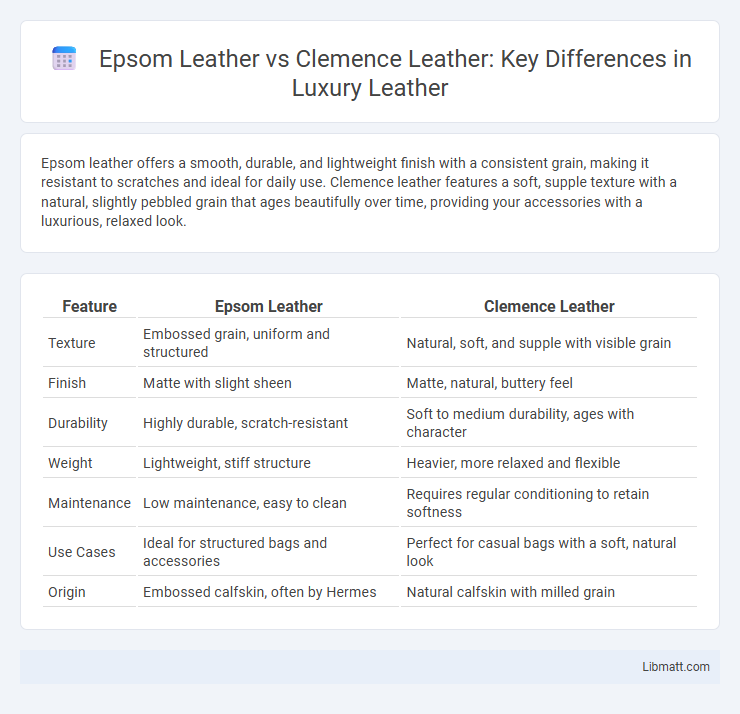Epsom leather offers a smooth, durable, and lightweight finish with a consistent grain, making it resistant to scratches and ideal for daily use. Clemence leather features a soft, supple texture with a natural, slightly pebbled grain that ages beautifully over time, providing your accessories with a luxurious, relaxed look.
Table of Comparison
| Feature | Epsom Leather | Clemence Leather |
|---|---|---|
| Texture | Embossed grain, uniform and structured | Natural, soft, and supple with visible grain |
| Finish | Matte with slight sheen | Matte, natural, buttery feel |
| Durability | Highly durable, scratch-resistant | Soft to medium durability, ages with character |
| Weight | Lightweight, stiff structure | Heavier, more relaxed and flexible |
| Maintenance | Low maintenance, easy to clean | Requires regular conditioning to retain softness |
| Use Cases | Ideal for structured bags and accessories | Perfect for casual bags with a soft, natural look |
| Origin | Embossed calfskin, often by Hermes | Natural calfskin with milled grain |
Introduction to Epsom and Clemence Leather
Epsom leather is a durable, embossed calfskin known for its resistance to scratches and structured finish, making it ideal for maintaining shape in handbags and accessories. Clemence leather offers a soft, supple texture with a natural grain pattern that ages beautifully over time, providing a more relaxed and luxurious feel. Your choice between these two leathers depends on whether you prefer a firm, polished look or a flexible, textured finish.
Origin and History of Epsom Leather
Epsom leather, developed by Hermes in the 1990s, is a finely embossed calfskin known for its durable and structured texture, making it highly resistant to scratches and easy to maintain. Unlike Clemence leather, which originates from the French term relating to calm or gentleness and features a softer, more supple pebbled grain from baby bull hides, Epsom leather's synthetic embossing process gives it a uniform appearance that holds its shape exceptionally well. Your choice between Epsom and Clemence leathers depends on whether you prefer a lightweight, structured finish or a more relaxed, plush feel.
Origin and History of Clemence Leather
Clemence leather originates from France and is renowned for its natural, soft grain and durability, traditionally derived from high-quality calf or cowhide. Its hallmark is a supple texture with a matte finish, achieved through a slow tanning process that preserves the leather's natural characteristics. This type of leather gained popularity in luxury goods, especially handbags, due to its resistance to scratching and ability to age gracefully.
Texture and Appearance Comparison
Epsom leather features a fine, embossed grain that creates a consistent, uniform texture, offering a sleek and modern appearance ideal for a polished look. Clemence leather displays a more natural, pebbled texture with larger, softer grains, giving it a relaxed, supple feel and a slightly matte finish that improves with age. Your choice between Epsom and Clemence leather depends on whether you prefer a structured, scratch-resistant surface or a soft, textured patina that develops character over time.
Durability and Scratch Resistance
Epsom leather offers exceptional scratch resistance due to its embossed, pressed texture, making it highly durable for everyday use while maintaining its appearance over time. Clemence leather, made from natural cowhide with a supple, pebble-grain finish, provides excellent durability but is more prone to visible scratches that develop a vintage patina. For owners seeking low-maintenance durability with minimal visible wear, Epsom leather is preferable, whereas Clemence appeals to those who value natural aging and softness despite higher scratch susceptibility.
Weight and Structure Differences
Epsom leather is lightweight with a rigid, embossed texture that maintains its shape and resists scratches, making it ideal for structured bags. Clemence leather is heavier, softer, and features a natural grain with a relaxed, supple structure that develops character over time. Understanding these weight and structure differences can help you choose the right leather for your desired durability and aesthetic.
Maintenance and Care Tips
Epsom leather requires minimal maintenance due to its durable, embossed texture that resists scratches and stains, making it ideal for everyday use with gentle wiping and occasional conditioning. Clemence leather demands more careful upkeep, including regular moisturizing to preserve its soft, natural grain and prevent drying or cracking over time. Your choice between these leathers depends on the level of maintenance you are willing to invest, with Epsom offering easier care and Clemence requiring more attentive preservation.
Popular Uses in Luxury Goods
Epsom leather is widely popular in luxury handbags and small accessories due to its lightweight, structured form and scratch-resistant qualities, making it ideal for daily use items such as wallets and belts. Clemence leather is favored for more supple luxury goods including larger bags and totes, prized for its soft, matte texture and natural grain that ages gracefully with time. Your choice between Epsom and Clemence leather ultimately depends on the desired balance of durability and softness in high-end leather products.
Price and Value Considerations
Epsom leather typically offers a more affordable price point compared to Clemence leather, making it an attractive option for those seeking durability with a lower investment. Clemence leather, prized for its rich texture and supple finish, commands a higher price but delivers exceptional softness and a luxurious aging process, enhancing its long-term value. Your choice depends on whether you prioritize initial cost savings or the premium feel and evolving patina that Clemence leather provides over time.
Which Leather is Best for You?
Epsom leather features a fine, embossed grain that resists scratches and maintains shape, making it ideal for everyday use and those seeking durability with minimal maintenance. Clemence leather, known for its soft, supple texture and natural grain, offers a relaxed, luxurious feel perfect for those who prefer a more vintage look and comfortable touch. Your choice depends on whether you prioritize long-lasting structure and scratch resistance (Epsom) or a softer, more pliable leather that develops character over time (Clemence).
Epsom leather vs clemence leather Infographic

 libmatt.com
libmatt.com